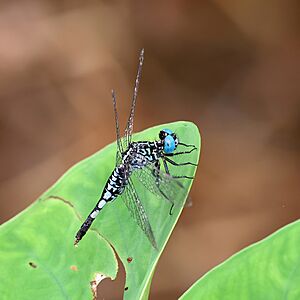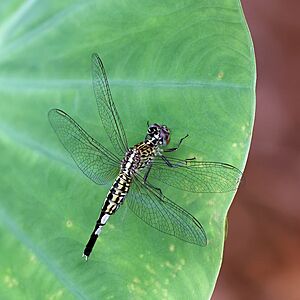Asian pintail facts for kids
Quick facts for kids Asian pintail |
|
|---|---|
 |
|
| Male | |
 |
|
| Female both in Phuket, Thailand |
|
| Conservation status | |
| Scientific classification |
The Asian pintail (scientific name: Acisoma panorpoides) is a small and interesting type of dragonfly. People also call it the trumpet tail or grizzled pintail. It belongs to a family of dragonflies called Libellulidae, which are often known as "skimmer" dragonflies.
Where It Lives
The Asian pintail dragonfly lives across a large part of Asia. You can find it from the Indian subcontinent all the way to Japan, the Philippines, and Indonesia. This means it's quite common in many warm, wet places.
What It Looks Like
This dragonfly is quite small. Males have bright blue eyes. Their body, called the thorax, is a lovely sky-blue color mixed with black. This creates a cool pattern on their back and sides.
Their long body, called the abdomen, is also sky-blue with black markings. The first five parts of the abdomen have thin black lines and wider black edges underneath. There's also a black stripe on top that gets wider at certain spots. You might see small black speckles on the sides of the first four segments.
The last few segments (6 to 10) are mostly black. The very end of its body has bluish-white parts.
Female Asian pintails look a lot like the males. However, their eyes are usually greenish-yellow. Their thorax and the first five parts of their abdomen are also more greenish-yellow instead of blue.
One special thing about this dragonfly is the unique shape of its abdomen. This shape helps you tell it apart from other dragonflies in the Libellulidae family.
Where It Likes to Live
Asian pintails prefer wet, muddy places. You'll often find them in subtropical or tropical swamps and marshy areas. They especially like ponds and lakes that have lots of weeds and tall reeds growing in them.
These dragonflies are not very strong fliers. They tend to fly slowly and stay very close to the plants and reeds. This is where they also lay their eggs and where their young grow up.




